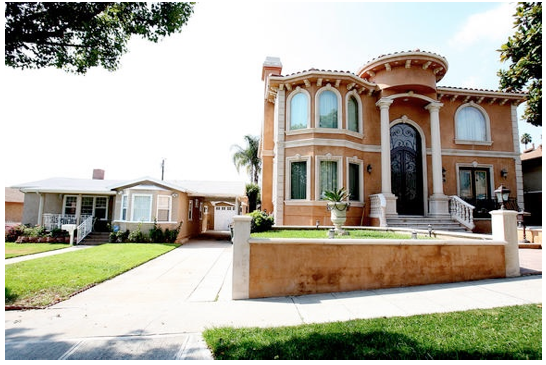CommentsPLATKIN ON PLANNING-A brief note: Opponents of the Neighborhood Integrity Initiative have repeatedly claimed that it would block the construction of new affordable housing. In CityWatch I have twice asked readers to send me any addresses where that has been the case. I have also reached out to experts at USC and UCLA with the same question. So far, I have only heard a second hand anecdote, but no specifics yet. I’m still waiting. If readers can send me any details…a location and any zone changes and General Plan Amendments that were required to proceed with an affordable housing project, I would appreciate it. Until then I will assume that this is a baseless claim concocted by supporters of luxury high rise projects intent on preserving the business model of their patrons.
CityWatch readers probably know that the City Planning Department is trying one more time to prepare and adopt an ordinance to finally stop the mansionization of LA’s single family neighborhoods.
Part of their motivation is that there are few cases of land use that arouse as much as wrath as McMansions -- those big, boxy, pricey, and cheaply constructed houses that are often mistaken for apartment buildings.
Consider the following:
Some people hate them because they conflict with the City Planning Commission’s anti-mansionization policies contained in their Do Real Planning manifesto.
Some people hate them because they conflict with the policies of the Framework Element, a key part of LA’s General Plan. The Framework is clear that new residential developments must respect the character and scale of existing residences. But, as anyone can see when driving through neighborhoods blighted by mansionization, the scale and character of McMansions intensely clash with existing homes, whether they are Spanish Revival, Tudor, mid-century, or even ranch-style.
Some people hate them because they displace existing affordable housing. Nearly all of the 2000 homes that the mansionizers bulldoze each year in Los Angeles are small starter homes. Most of them are less than 2000 square feet, and they cost about 1/3 of the Big Macs that replace them. LA’s housing crisis did not just happen. It has multiple causes, one of which is mansionization, whether it involves losing single family homes and duplexes or the creation of Single Lot Subdivisions.
Last, but hardly least, some people hate them because of their energy-intensive, environmentally unfriendly character. To say the least, McMansions are the least sustainable housing option out there, short of a castle, or to be generous, a real mansion.
And also consider this:
- Their giant footprints cover much of their lots, so there is little open space for rain to percolate into the ground or for plants to sequester carbon and produce oxygen.
- Their boxiness makes them very hot in LA’s sunny climate, so the owners have no choice but to run their air conditioning around the clock. And, as LA heats up through climate change, those air conditioning units will try to keep up, spewing out even more heat and air pollution in a downward spiral.
- To sell McMansions to their status-conscious buyers, the contractors install outsized appliances, such as enormous restaurant stoves. Sometimes they throw in energy-hungry extras, like whole house vacuum systems with every room featuring a vacuum outlet. The result is enormous electric bills.
- To further appeal to these “discriminating” buyers, the contractors install pools and spas, forcing up water bills to keep them filled with fresh water, generating large electric or gas bills to heat them.
- LA’s new building codes require sprinklers in each room for potential fires and as a result, the DWP must install new two inch pipes for each McMansion to assure sufficient water pressure. The old standard one inch pipes are either left in the ground or hauled off as scrap.
- McMansions routinely include two or even three car attached garages. This feature not only incentivizes automobile driving, but the new double driveways also wipe out green space and trees in front yards and parkways. But since the attached garages are routinely used for recreation, storage, and other habitable uses, the owners park their luxury cars on their front yard driveways, next to sidewalks.
- McMansions create enormous amounts of rubble because they require the demolition of existing houses, most of which contains dangerous asbestos and lead paint that the contractors – with a wink and a nod from Building and Safety -- fail to remediate.
- Because McMansions are huge, they devour enormous amounts of construction materials, such as cement, metals, plastics, and wood. Furthermore, because they are shoddily constructed, they will have a short life-span. Future buyers will quickly tear them down to avoid the extensive repairs necessary to keep McMansions habitable. This short life span, then, also adds to the rubble created by the mansionization process.
- McMansions are higher and larger than adjacent houses, and this means they create much more shadowing than the smaller houses they replace. Neighbors are impacted by loss of sunlight in their yards and gardens, as well as by reduced opportunities to efficiently run roof top solar panels.
When these many unsustainable features are considered, it is clear that any serious effort to create a sustainable Los Angeles, such as the Climate Action Plans prepared by Mayors Villaraigosa and Garcetti, should have the mansionization process in its cross-hairs. Claims of mitigating the causes of climate change, or adapting to climate change as it worsens, will ring hollow if yet another mansionization ordinance is riddled with more loopholes that allow the continued construction of McMansions.
(Dick Platkin is a former Los Angeles city planner who reports on planning issues in Los Angeles for CityWatch. He welcomes comments, questions, and corrections at [email protected].) Edited for CityWatch by Linda Abrams.
Explore
Our mission is to promote and facilitate civic engagement and neighborhood empowerment, and to hold area government and its politicians accountable.

 CityWatch Los Angeles
Politics. Perspective. Participation.
CityWatch Los Angeles
Politics. Perspective. Participation.
27
Sun, Apr















